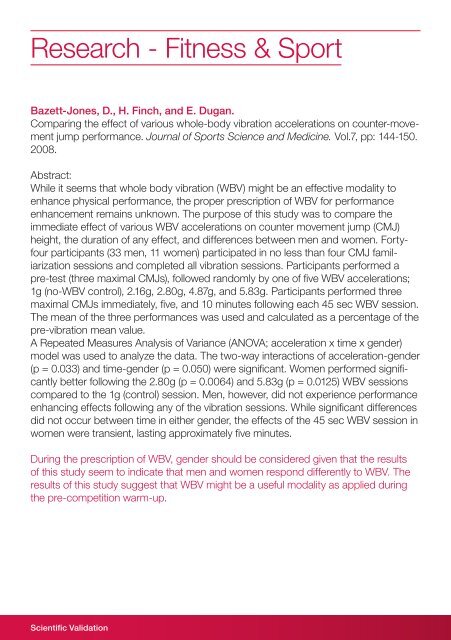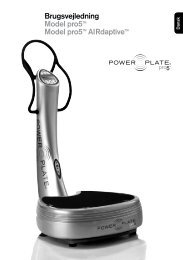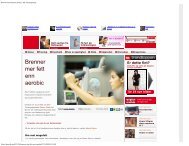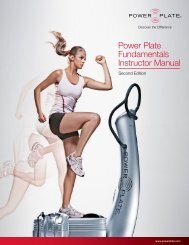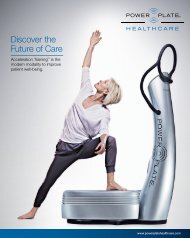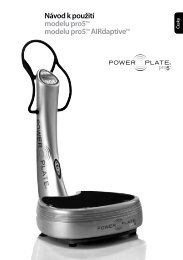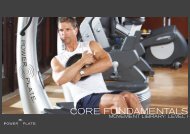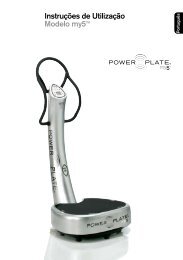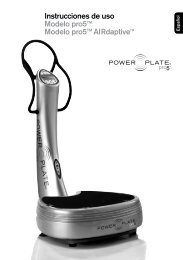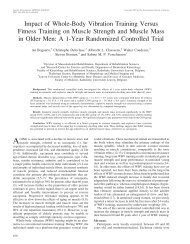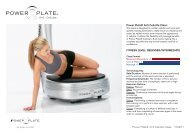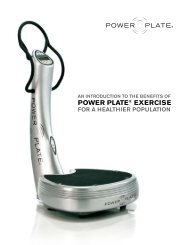Power Plate®
Power Plate®
Power Plate®
Create successful ePaper yourself
Turn your PDF publications into a flip-book with our unique Google optimized e-Paper software.
Research - Fitness & Sport<br />
Bazett-Jones, D., H. Finch, and E. Dugan.<br />
Comparing the effect of various whole-body vibration accelerations on counter-movement<br />
jump performance. Journal of Sports Science and Medicine. Vol.7, pp: 144-150.<br />
2008.<br />
Abstract:<br />
While it seems that whole body vibration (WBV) might be an effective modality to<br />
enhance physical performance, the proper prescription of WBV for performance<br />
enhancement remains unknown. The purpose of this study was to compare the<br />
immediate effect of various WBV accelerations on counter movement jump (CMJ)<br />
height, the duration of any effect, and differences between men and women. Fortyfour<br />
participants (33 men, 11 women) participated in no less than four CMJ familiarization<br />
sessions and completed all vibration sessions. Participants performed a<br />
pre-test (three maximal CMJs), followed randomly by one of five WBV accelerations;<br />
1g (no-WBV control), 2.16g, 2.80g, 4.87g, and 5.83g. Participants performed three<br />
maximal CMJs immediately, five, and 10 minutes following each 45 sec WBV session.<br />
The mean of the three performances was used and calculated as a percentage of the<br />
pre-vibration mean value.<br />
A Repeated Measures Analysis of Variance (ANOVA; acceleration x time x gender)<br />
model was used to analyze the data. The two-way interactions of acceleration-gender<br />
(p = 0.033) and time-gender (p = 0.050) were significant. Women performed significantly<br />
better following the 2.80g (p = 0.0064) and 5.83g (p = 0.0125) WBV sessions<br />
compared to the 1g (control) session. Men, however, did not experience performance<br />
enhancing effects following any of the vibration sessions. While significant differences<br />
did not occur between time in either gender, the effects of the 45 sec WBV session in<br />
women were transient, lasting approximately five minutes.<br />
During the prescription of WBV, gender should be considered given that the results<br />
of this study seem to indicate that men and women respond differently to WBV. The<br />
results of this study suggest that WBV might be a useful modality as applied during<br />
the pre-competition warm-up.<br />
Boland, E., D. Boland, T. Carroll, and W.R. Barfield.<br />
Comparison of the <strong>Power</strong> Plate and free weight exercises on upper body muscular<br />
endurance in college age subjects. International Journal of Exercise Science. Vol. 2(3),<br />
pp: 215-222. 2009.<br />
Abstract:<br />
The power plate (PP) is designed to reduce training time while providing a muscle<br />
stimulus that leads to positive changes in muscle mass. This study investigated the<br />
effect that training on the PP has compared to a free-weight (FW) program, on upper<br />
body endurance, defined as the number of push-ups completed at one time prior to<br />
failure. Following IRB approval a pre-test was used to assess push-up endurance in<br />
PP and FW cohorts. Each group exercised for six consecutive weeks, working out<br />
three times per week, on non-consecutive days performing five exercises of two sets<br />
of 8-12 repetitions. Twenty-two females and 2 males enrolled in the investigation.<br />
Eleven with a mean age of 22 years (20-24) participated in the PP cohort. Thirteen<br />
participated in the FW arm of the study with a mean age of 24.5 (20-29) years. Shapiro-Wilk<br />
found lack of data normality. Wilcoxon Rank Sum testing yielded statistically<br />
significant differences within groups. The FW comparison between pre and post test<br />
showed a p value of 0.016. The PP group pre to post test p value was 0.005. Nonparametric<br />
testing (Mann Whitney) found no statistical differences (p=0.62) between<br />
Group A (FW) and Group B (PP) on the push-up pre-test. The post-test comparing<br />
post testing differences between groups (PP and FW) found no statistical differences<br />
(p=0.55) in the push-up test. Subjects in both groups saw increases in upper-body<br />
endurance with statistically significant differences within groups.<br />
Based on our findings the PP is a useful tool which enhances upper body muscle<br />
endurance.<br />
Scientific Validation 21


